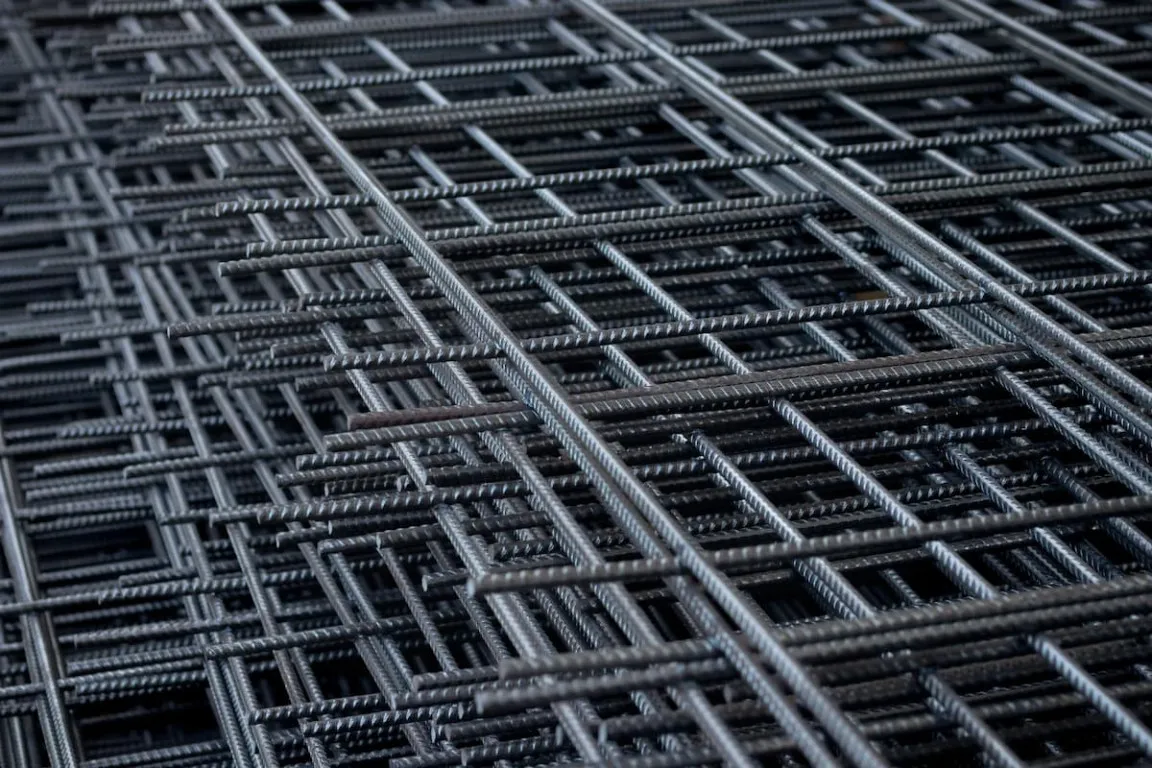Concrete steel is an important element in building construction projects that plays a role in providing strength and maintaining the stability of buildings. The use of concrete steel must be calculated accurately to ensure that the building structure is safe and free from various potential risks.
Accurate calculations not only ensure strength but also support building timeline management and cost efficiency. Therefore, it is important to understand how to calculate the weight of concrete steel, as well as its types, sizes, uses, drawbacks, and advantages. To discover more, read this article to the end.
What Is Concrete Steel?
Concrete steel is round reinforcing steel that functions as the framework of a building. In English, concrete steel is often referred to as rebar, while in Indonesia, it is commonly known as baja tulangan or besi tulangan.
Historically, concrete steel was invented by Joseph Monier, a French gardener, in 1850. Monier initially experimented with making flower pots and concrete roof slabs using clay and wood as the main materials. However, both materials were prone to damage.
Later, Monier tried making pots and concrete containers using a mixture of cement and steel wires arranged in parallel. This experiment was successful and demonstrated that the use of steel wires could create lightweight structures with maximum strength.
In 1867, Monier obtained a patent for his invention. To this day, the use of concrete steel remains highly beneficial and essential in building construction.
Reinforced concrete has widespread applications as building frameworks, making it a material that must comply with the Indonesian National Standard (SNI) set by the government.
Commonly Used Concrete Steel Sizes
Although concrete steel must meet Indonesian National Standard (SNI), there are commonly used concrete steel sizes in various constructions, as follows:
- Concrete steel size Ø 8 mm: This size is often used to make light structural elements, such as floor reinforcement, walls, pools, beams, and various other small structures.
- Concrete steel size Ø 10 mm: This size is often used for lightweight reinforced concrete structures, such as slabs and walls, as well as various constructions requiring high strength.
- Concrete steel size Ø 12 mm: This size is typically used in reinforced concrete structures for larger beams and columns, and is also suitable for supporting heavier loads.
- Concrete steel size Ø 16 mm: This size is commonly used for structures requiring greater load-bearing capacity, such as foundations and main columns of multi-story buildings.
- Concrete steel sizes Ø 19 mm and 25 mm: These sizes are used for constructing heavy-duty building structures, such as foundations and various main building structures.
Read also: Concrete Grade Types and Classification Table
How to Calculate the Weight of Concrete Steel
After learning about the various sizes of concrete steel, it is also important to understand how to calculate the weight of concrete steel. Here are some formulas for calculating concrete steel that you can use.
1. Calculating the Weight of Concrete Steel
The first formula you need to understand is the formula for calculating the weight of concrete steel required in a construction based on length and weight per meter (kg/m). This formula is important for determining the amount of material you need to order. Here is the formula:
Weight (kg) = Length (m) x Weight per Meter (kg/m)
2. Calculating the Total Weight of Concrete Steel
Accurate calculations are essential to avoid losses in the procurement and management of concrete steel in a building construction project. This formula can be used to simplify the planning of concrete steel procurement for construction, ensuring the quantity aligns with requirements.
The formula for calculating the total weight of concrete steel is as follows:
Total Weight (kg) = Total Length of Concrete Steel (m) × Weight per Meter (kg/m)
Types of Concrete Steel
There are several types of concrete steel that are commonly used in various constructions. These types of concrete steel can be distinguished by their function and shape. Here are the types of concrete steel that are important for you to understand:
1. Plain Concrete Steel
The first type of concrete steel is plain concrete steel. This type has a smooth surface without any grooves or fins.
Generally, plain concrete steel is used to create reinforced concrete structures that do not require a high level of strength between the steel and the concrete. This type is typically used in construction projects such as floor casting, partition walls, and other small structural constructions.
2. Deformed Bar
This type of concrete steel has ridges or grooves on its surface, which serve to enhance the bond strength between the bar and the concrete.
Deformed bars are typically used in building construction that requires strong and optimal bonding strength, such as columns, beams, and floor slabs.
The fins or grooves on the concrete steel can provide higher tensile strength while also offering greater durability, making this type suitable for use in building structures that must bear heavy loads.
3. Low-Grade Concrete Steel
There is also low-grade concrete steel, which is a type of low-quality concrete steel often used in building structures that do not require high durability, such as temporary projects.
However, low-grade concrete steel is rarely used in large construction projects because it is less durable than plain concrete steel and threaded concrete steel.
4. Stirrups Concrete Steel
Next, there are stirrup concrete steel, which have high adhesion, making them commonly used in large-scale construction projects such as bridge construction or high-rise buildings.
Stirrups concrete steel are fitted with reinforcements or grooves arranged in a regular pattern on the surface of the steel. Due to this design, stirrup concrete steel can distribute loads evenly across the entire concrete structure.
5. Graded Concrete Steel
This type of concrete steel is specially manufactured through high-temperature heating or cooling processes. This manufacturing process gives graded concrete steel high durability and a more flexible structure than other types.
Graded reinforcing bars are often used in construction projects requiring special durability specifications due to repeated loads, such as bridges.
Advantages and Disadvantages of Concrete Steel
Due to its crucial role in building construction, it is important to understand the advantages and disadvantages of concrete steel as a consideration for using this element in your construction project.
1. Advantages of Concrete Steel
Concrete steel has various advantages that are beneficial for your construction project. Here are some of the advantages of concrete steel for your building construction:
- It has a strong and sturdy structure, so its compressive strength is higher than that of other construction materials.
- It is more durable and can withstand long-term use without losing its strength under load.
- It is resistant to heat and cold.
- It is corrosion-resistant and fire-resistant.
- It is easy to shape, such as into beams, columns, plates, dome roofs, and others. Installing concrete steel is easier than installing heavy steel structures.
- Maintenance costs are low, almost negligible.
- The cost of supporting materials is also affordable, such as bridge supports, foundation pads, and others.
2. Disadvantages of Concrete Steel
Although concrete steel has many advantages, it also has disadvantages that you need to consider. The following are some of its disadvantages:
- The construction time tends to be longer.
- It has low tensile strength, so it requires the use of tensile reinforcement.
- The cost of formwork is quite expensive, approximately one-third to two-thirds of the total cost of the concrete structure.
- Quality depends on the manufacturer of the concrete steel.
Examples of Concrete Steel Use
There are also examples of reinforcing steel use in plain concrete and threaded concrete that are important to understand in depth because these two types of reinforcing steel are the most commonly used in building construction.
1. Examples of Plain Concrete Steel Use
Plain bar concrete steel is often used in the manufacture of construction reinforcement. This is because plain concrete steel has high tensile strength and is sturdy.
In addition to making construction reinforcement, plain concrete steels are also often used to assemble formwork. This is because plain concrete steel is easy to shape, making it easier for workers to assemble formwork using this type of concrete steel.
2. Example of the Use of Deformed Bars
Meanwhile, deformed bars are more commonly used in the construction of skyscrapers. Deformed bars have high tensile strength, making them more sturdy and capable of withstanding heavier building loads.
In addition, deformed bars are also commonly used in bridge construction. Generally, bridge construction requires materials that can withstand various loads from movements above them, so deformed bars are suitable for use in this type of construction project due to their strong tensile strength.
Read also: The Right Concrete Mix Ratio According to the SNI Standards
The Process of Making Concrete Steel
The process of making concrete steel is quite interesting and involves various processes, each of which has its important function. Before discussing the manufacturing process, it is also important to understand the raw materials used to make concrete steel.
Concrete steel is made from heated steel billets, which generally have a cross-section size of 100 mm x 100 mm, 110 mm x 110 mm, or 120 mm x 120 mm, and lengths of 6 m, 10 m, or 12 m.
Generally, steel billets themselves are made from various types of iron ore and scrap with various added elements, such as chromium, manganese, nickel, vanadium, graphite, lime, coke or fuel, and ferroalloys.
The following is the sequence of the concrete steel production process:
- Cutting material: The first process is cutting material. In this process, steel billets are cut to the required width and length for the construction using a cutting machine.
- Warming process raw: In this process, the cut steel billets are heated in a soaking zone at a temperature of 950–1150°C for approximately two hours to raise the steel temperature to 1000–1350°C.
- Cutting oil: The next process involves spraying water mixed with oil to lower the steel temperature.
- Roughing: This process can be referred to as the cleaning process, where the steel billet that has been removed and still has residue left over from the smelting process is peeled and discarded while spraying cutting oil to lower its temperature.
- Intermediate: The steel billet is placed in a temperature control machine to stabilize its temperature before entering the rolling process.
- Rolling: In this process, the steel billet is rolled using a finishing mill machine, which resembles a rolling process. For plain steel bars, the rolling process uses a smooth surface, while for threaded steel bars, the rolling process uses a ribbed surface.
- Cooling: After being cast, the concrete steel is cooled using a cooling bed machine.
- Cutting: Once the concrete steel has cooled completely, it is cut. There are two cutting length criteria: 12 m and 6 m.
Tips for Choosing Concrete Steel
To avoid making mistakes when choosing concrete steel for your building construction materials, there are several tips you can apply when purchasing concrete steel. Here are some tips:
1. Understand the Types and Sizes of Concrete Steel
The first tip is to understand the various types and sizes of concrete steel. This is so that you do not choose the wrong concrete steel for your construction, as each type of concrete steel has different sizes and uses.
2. Check the Concrete Steel Brand and SNI Standards
It is also important to know the brand of the concrete steel and ensure that the brand has Indonesian National Standard (SNI) certification. This is important because it will affect the quality of the concrete steel you receive.
3. Purchase from a Trusted Distributor
Lastly, ensure that you purchase concrete steel from a trusted distributor who can provide transparent and clear information to avoid selecting the wrong concrete steel for your construction needs.
Those are various explanations about concrete steel, starting from its definition, various types and sizes, advantages, disadvantages, manufacturing methods, along with tips for choosing the best concrete steel for your construction needs.
All of this information is important for you to understand, especially to ensure that your construction project gets the best products from trusted manufacturers, such as Semen Merah Putih.
Through its subsidiary, Merah Putih Beton, Semen Merah Putih is committed to providing its premium concrete product, Ready Mix Concrete, which is a ready-to-use concrete made from a concrete mixture produced at a batching plant with the precise proportions of materials and following project specifications.
Ready Mix Concrete is also an efficient and effective choice for your building construction due to its high quality and fast delivery process, which does not disrupt construction project productivity.
Additionally, there is Precast Concrete, which is of high quality and can further streamline construction time due to its practicality and high-quality standards, precision, and strength, thereby supporting the construction of sturdy buildings.
Contact us for more detailed information about the various premium products from Semen Merah Putih and further consultation regarding your building construction.
Read also: Ready Mix Concrete: Types, Grades, and How to Make It



